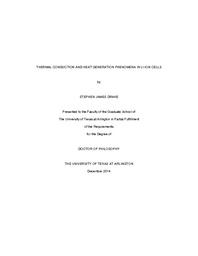
ATTENTION: The works hosted here are being migrated to a new repository that will consolidate resources, improve discoverability, and better show UTA's research impact on the global community. We will update authors as the migration progresses. Please see MavMatrix for more information.
Show simple item record
| dc.contributor.author | Drake, Stephen | en_US |
| dc.date.accessioned | 2015-07-01T17:50:26Z | |
| dc.date.available | 2015-07-01T17:50:26Z | |
| dc.date.issued | 2014-12 | |
| dc.date.submitted | January 2014 | en_US |
| dc.identifier.other | DISS-12898 | en_US |
| dc.identifier.uri | http://hdl.handle.net/10106/24930 | |
| dc.description.abstract | Cylindrical lithium ion (Li-ion) cells have demonstrated high power density and energy capacity among other energy storage devices. Despite their already widespread use, the thermal transport properties of cylindrical Li-ion batteries are not well documented and understood, while a sizable amount of work has been carried out for electrical, electrochemical, and materials optimization of Li-ion cells. These thermal phenomena are particularly important for high discharge rate batteries. With this uncertainty, if thermophysical properties are not accounted for in thermal models, the result may be a significant under-prediction or over-prediction of the temperature field in a Li-ion cell.Experimental techniques are described that measure the thermal transport properties and heat generation rate in Li-ion cells. The anisotropic thermal conductivity and heat capacity of a Li-ion cell is measured using an adiabatic unsteady heating method. A cylindrical Li-ion cell is subjected to radial or axial heating on one of its outer surfaces, while all other surfaces are kept adiabatic. Experimental measurements indicate that radial thermal conductivity is around two orders of magnitude lower than axial thermal conductivity. Further, a variety of cells of varying shapes and sizes are characterized, including prismatic and pouch form-factor cells. The effect of the cell's state of charge (SOC) and temperature induced accelerated aging on its thermophysical properties is also investigated.An experimental technique is also developed for measuring the steady-state heat generation in a thermal test cell similar to a Li-ion cell. A heat flux sensor is applied to the curved surface of the test cell. Verified with an analytical model, this method predicts the value of the heat generation rate with an error of less than 10%. This model is constrained to a truncated experimental data set when data for only a short time may be available. The accuracy improves as the amount of available data increases. In this approach, it is not important to know material property values, which further adds to the simplicity and ease of the measurement.Heat generation measurement on an actual Li-ion cell undergoing high rate discharge presents additional challenges. Towards this, the method described has been extended. Testing was first performed using the thermal test cell for real-time heat generation capture followed by 26650 cells at discharge rate of up to 9.6C. Measuring cell temperature and surface heat flux enables in situ heat generation rate as a function of time. Thermal measurements are within around 10% of well-known theoretical models based on electrical parameters at higher rates at which the cell can discharge - often referred to as its C-rate.This work addresses multiple important voids in thermal understanding of Li-ion cells by describing relatively simple methods for thermal characterization. It is expected that this experimental work will result in a complete and robust method for thermophysical property determination and real-time heat generation measurement in Li-ion cells. These results will improve the understanding of thermal characteristics in cells and provide better cell performance by increasing safety and extend operational life. | en_US |
| dc.description.sponsorship | Jain, Ankur | en_US |
| dc.language.iso | en | en_US |
| dc.publisher | Mechanical Engineering | en_US |
| dc.title | Thermal Conduction And Heat Generation Phenomena In Li-ion Cells | en_US |
| dc.type | Ph.D. | en_US |
| dc.contributor.committeeChair | Jain, Ankur | en_US |
| dc.degree.department | Mechanical Engineering | en_US |
| dc.degree.discipline | Mechanical Engineering | en_US |
| dc.degree.grantor | University of Texas at Arlington | en_US |
| dc.degree.level | doctoral | en_US |
| dc.degree.name | Ph.D. | en_US |
Files in this item
- Name:
- Drake_uta_2502D_12898.pdf
- Size:
- 5.749Mb
- Format:
- PDF
This item appears in the following Collection(s)
Show simple item record


